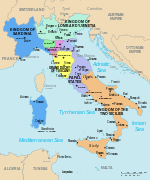Order of the Holy Sepulchre: Difference between revisions
m Robot - Removing category Order of the Holy Sepulchre per CFD at Wikipedia:Categories for discussion/Log/2015 June 24. |
|||
| Line 147: | Line 147: | ||
*Knight / Dame (KHS / DHS) |
*Knight / Dame (KHS / DHS) |
||
In some jurisdictions the term "Lady" is used rather than "Dame," but this is a misnomer since the honorific term of Lady (Donna) refers to the wife of a Knight (Cavaliere). However, a woman upon whom the Order has been conferred is properly termed a "Dame" (Dama). <br /> |
In some jurisdictions the term "Lady" is used rather than "Dame," but this is a misnomer since the honorific term of Lady (Donna) refers to the wife of a Knight (Cavaliere). However, a woman upon whom the Order has been conferred is properly termed a "Dame" (Dama). <br /> |
||
This Order is the highest distinction given to both laity and clergy. While laity can receive or be promoted to any rank, clergy's ranks are restricted thusly: Cardinals automatically are Knights Grand Cross; Bishops are automatically Commanders with Star; and priests start with the rank of Knight but may be promoted to Commander. |
|||
The Order of the Holy Sepulchre is State Honour bestowed nowadays by the Holy See on reigning Catholic monarchs or members of their royal families. Kings, Queens, Princes and Princesses are either given the rank of Collar or Grand Cross. Monarchs, Crown Princes and their consorts from Spain, Monaco, Belgium and Liechtenstein currently are, or previously have been, members of this Order. |
|||
Since the Order has its roots in the Canons of the Holy Sepulchre, priests of the Order are afforded the honorary rank of "Canons of the Holy Sepulchre," and they are entitled to the insignia of a Canon (i.e. mozetta for choir dress). Some of the priests of the Order prefer the honorary term of Canon to the title of Knight, which carries a connotation that may be considered improper for a priest. All priests who have been conferred knighthood in the Order may use the term "Canon," which is different from the title that is conferred by the Latin Patriarch of Jerusalem. However, the late Grand Master, John Cardinal Foley, said that this would be better applied to those priests who have the rank of Commander. |
|||
Members of the Order may receive awards of Special Distinction, and those Knights and Dames making a pilgrimage to the Holy Land receive the Pilgrim's Shell. These are generally awarded by the Grand Prior of the Order, the Latin Patriarch of Jerusalem. |
Members of the Order may receive awards of Special Distinction, and those Knights and Dames making a pilgrimage to the Holy Land receive the Pilgrim's Shell. These are generally awarded by the Grand Prior of the Order, the Latin Patriarch of Jerusalem. |
||
| Line 154: | Line 160: | ||
The honor of knighthood, and any subsequent promotions, are conferred by the Holy See through its [[Secretariat of State (Holy See)|Secretariat of State]], which approves each in the name of and by the authority of the Pope. Each diploma of appointment once approved is sealed and signed in Rome by an official of the Secretariat of State (The Assessor for General Affairs) and the Cardinal Grand Master of the Order. The candidate is subsequently knighted or promoted in an elaborate ceremony with a cardinal or major prelate presiding. |
The honor of knighthood, and any subsequent promotions, are conferred by the Holy See through its [[Secretariat of State (Holy See)|Secretariat of State]], which approves each in the name of and by the authority of the Pope. Each diploma of appointment once approved is sealed and signed in Rome by an official of the Secretariat of State (The Assessor for General Affairs) and the Cardinal Grand Master of the Order. The candidate is subsequently knighted or promoted in an elaborate ceremony with a cardinal or major prelate presiding. |
||
Members of the Order are precluded from joining any other a Order that is Masonic or not recognized by a sovereign state, and must renounce any membership in such organisations before being appointed a Knight of the Holy Sepulchre. Members may be expelled from the Order in circumstances where they breach its rules of conduct. |
|||
<center> |
<center> |
||
Revision as of 12:04, 27 August 2015
| Equestrian Order of the Holy Sepulchre of Jerusalem | |
|---|---|
 Arms of the Order of the Holy Sepulchre | |
| Active | c. 1099 – present |
| Allegiance | Holy See |
| Type | Catholic order of knighthood |
| Headquarters | Palazzo Della Rovere, Vatican City |
| Nickname(s) | Order of the Holy Sepulchre |
| Patron | Godfrey of Bouillon |
| Motto(s) | Deus Lo Vult |
| Attire | White cape with a red Jerusalem cross (knights) Black cape with a red Jerusalem cross bordered with gold (dames) |
| Commanders | |
| Grand Master | Edwin Frederick Cardinal O'Brien |
| Grand Prior | Fouad Twal |
The Equestrian Order of the Holy Sepulchre of Jerusalem (lat.: Ordo Equestris Sancti Sepulcri Hierosolymitani, OESSH) is a Roman Catholic order of knighthood under the protection of the Pope.[1] It traces its roots to Duke Godfrey of Bouillon, principal leader of the First Crusade.[2] In 1496, Pope Alexander VI created the office of Grand Master of the Order, and the office was vested in the papacy where it remained until 1949 and since then a cardinal has been grand master. The Pope is sovereign of the Order, and it enjoys the protection of the Holy See and has its legal seat at Vatican City.[3]
Crusader period
Five major orders were formed in the Holy Land between the late 11th century and the early 12th century: the Knights of the Holy Sepulchre (circa 1099), Knights Templar (circa 1118), Knights Hospitaller (circa 1099) (St John), Knights of the Hospital of St Mary of Jerusalem (Teutonic Knights) and Knights of St Lazarus.
Templar knights who contracted leprosy were sent to the care of the Order of St Lazarus. These knights trained the brethren of St Lazarus in the military arts and were responsible for transforming the Order into a military one. William, Archbishop of Tyre, as well as other historians of the period, appeared unaware of the difference between the Orders of Saint Lazarus and Saint John, referring to them in their accounts simply as 'Hospitallers'. The latter were, and still are, called Hospitallers as they began as an Order of monks running the Hospital of St. John in Jerusalem shortly after the First Crusade. They had become militarised by the 1130s, and went on, with the Knights Templar, to become one of the two largest and most influential Military Orders. Indeed, Godfrey de Bouillon – the uncrowned ‘king’ of Jerusalem – was so impressed with the dedication of these hospital workers under its leader Gerard and with their work toward the sick and the wounded that 'king' Godfrey de Bouillon supported and gave them funds and facilities.
Pilgrimages to the Holy Land were a common if dangerous practice from shortly after the crucifixion of Jesus to throughout the Middle Ages. Numerous detailed commentaries have survived as evidence of this early Christian devotional. While there were many places the pious visited during their travels, the one most cherished was the Church of the Holy Sepulchre, first constructed by Constantine the Great in the fourth century AD. Tradition, begun long before the Crusades, provided for the bestowing of knighthood upon worthy men by the custodians of the Church of the Holy Sepulchre. Following the capture of Jerusalem at the end of the First Crusade in 1099, the Order was first formally constituted as an Order of Canons, the successor of which is the modern Equestrian Order of the Holy Sepulchre of Jerusalem. It is considered among the oldest of the military orders of knighthood. It was recognized by Papal Bull in 1113.[4][5][6]
End of Crusader period

The ultimate fall of the Kingdom of Jerusalem to the Muslims in 1291 did not suspend pilgrimages to the Tomb of Christ, or the custom of receiving knighthood there, and when the custody of the Holy Land was entrusted to the Franciscan Order, they continued this pious custom and gave the order its first Grand Master after the death of the last King of Jerusalem.
The official arrival of the Franciscan Friars Minor in Syria dates from the Bull addressed by Pope Gregory IX to the clergy of the Holy Land in 1230, charging them to welcome the Friars Minor, and to allow them to preach to the faithful and hold oratories and cemeteries of their own. In the ten years' truce of 1229 concluded between Frederick II of Sicily and the sultan Al-Kamil, the Franciscans were permitted to enter Jerusalem, but they were also the first victims of the violent invasion of the Khwarezmians in 1244. Nevertheless, the Franciscan province of Syria continued to exist, with Acre as its seat. In the territory of the Patriarchate of Jerusalem, reinstituted in 1847, the Franciscans still have 24 convents, and 15 parishes.[7]
The friars quickly resumed possession of their convent of Mount Sion at Jerusalem. The Turks tolerated the veneration paid to the tomb of Christ and derived revenue from the taxes levied upon pilgrims. In 1342, in his Bull Gratiam agimus, Pope Clement VI officially committed the care of the Holy Land to the Franciscans; only the restoration of a Latin Patriarchate of Jerusalem by Pius IX in 1847 superseded the Franciscans.
From the period 1291 to 1847, the Franciscan Custodian of Mount Sion was the only authority representing the Holy See in the Holy Land.[8] As early as 1336, the Franciscans were enrolling applicants among the lay Order of the Knights of the Holy Sepulchre, in ceremonies frequently mentioned in the itineraries of pilgrims. Those pilgrims deemed worthy of the honour were received into the Order with an elaborate ceremonial of ancient chivalry. In the ceremonial of reception, the role of the clergy was limited to the benedictio militis, the dubbing with the sword being reserved to a professional knight, since the carrying of the sword was incompatible with the sacerdotal character. This dubbing of knights was confirmed by Pope Leo X in 1516, and by Pope Clement VII in 1527.
In 1346 King Valdemar IV of Denmark went on a pilgrimage to Jerusalem and was made a Knight of the Holy Sepulchre — an act that increased the prestige of this King, who had considerable difficulty in establishing an effective rule over his Kingdom.[9]
From 1480 to 1495 there was in Jerusalem a German knight of the Holy Sepulchre, John of Prussia, who acted as steward for the convent and regularly discharged this act reserved to knighthood. It was also of frequent occurrence that a foreign knight, present among the crowds of pilgrims, would assist at this ceremony. However, in default of other assistance, it was the superior who had to act instead of a knight, although such a course was deemed irregular. It was since then also that the superior of the convent assumed the title of Grand Master, a title which has been acknowledged by various pontifical diplomas, and finally by a Bull of Benedict XIV dated 1746.
In 1489, Pope Innocent VIII suppressed the Order and ruled that it was to be merged with the Knights Hospitaller. In 1496, Pope Alexander VI restored the Order of Holy Sepulchre to independent status. Alexander VI decreed that the Order would no longer be governed by the office of custodian and further decreed that the senior post of the Order would henceforth be raised to the rank of Grand Master, reserving this title for himself and his successors.[10]
The Privileges of the Order,[8] recorded by the Guardian of the Order in 1553 and approved by successive Popes, included powers:
- to legitimise bastards
- to change a name given in baptism
- to pardon prisoners they might meet on the way to the scaffold
- to possess goods belonging to the Church even though they were laymen
- to be exempt from taxes
- to cut a man down from the gallows and to order him to be given a Christian burial
- to wear brocaded silk garments
- to enter a Church on horseback
- to fight against the Infidel
As late as the 18th century, all but the last were approved by Pope Benedict XIV who also stated that the Order should enjoy precedence over all Orders except over the Order of the Golden Fleece.
The Order today


Pius IX re-established the Latin Patriarchate of Jerusalem in 1847 and re-organized the Order whereby the Grand Master of the Order was to be the Latin Patriarch of Jerusalem, and the Order ceased to be a Pontifical Order. Pius X assumed the title of Grand Master again for the papacy in 1907, but in 1928 this was again relinquished by Pius XI in favour of the Patriarch of Jerusalem. In 1945, Pope Pius XII placed the Order under the patronage and protection of the Holy See, and in 1949, Pius XII approved new statutes, which included that the Grand Master be a Cardinal of the Roman Curia, and that the Latin Patriarch of Jerusalem be the Grand Prior of the Order.
The Order has a uniform which is only occasionally used in some jurisdictions, and Pius X ordained that the Order's cape or mantle, as worn by the original knights, be a "white cloak with the cross of Jerusalem in red".[11] Pius XII gave to the Order the Church and Monastery of St Onofrio in Rome as its international headquarters. The Grand Magisterium and administration are based at the Palazzo Della Rovere, the 15th-century palace of Pope Julius II, immediately adjacent to the Vatican on the Via della Conciliatione, which was also given to the Order by Pius XII, in 1949.
The Order is now primarily honorific. Its principal mission is to reinforce the practice of Christian life by its members in absolute fidelity to the Popes; to sustain and assist the religious, spiritual, charitable and social works of the Catholic Church in the Holy Land; and to conserve and propagate the faith in the Holy Land and the rights of the Catholic Church there. As it is a papal honor aspirant members must be practicing Catholics of good character, recommended by their local bishop with the support of several members of the Order, and are required to make a generous donation as "passage money" (echoing the ancient practice of crusaders paying their passage to the Holy Land) as well as an annual financial offering for works undertaken in the Holy Land. There is a provision for the Grand Master to admit members by motu proprio in exceptional circumstances and also for the officers of the Grand Magistery to occasionally recommend candidates to the Grand Master.[12]
Titular Canons
Titular Canons of the Holy Sepulchre include all priests ipso facto who have received Knighthoods in the Equestrian Order of the Holy Sepulchre of Jerusalem. Since the Order has its origins in the Canons of the Holy Sepulchre, priests of the Order have the honorary title of "Canon" in preference to the title of "Knight," which is more military in nature and less consistent with priestly ministry.[13] The Latin Patriarch of Jerusalem also confers the honorary title of "Canon of the Holy Sepulchre" upon priests and bishops.[14] Both Titular Canons of the Holy Sepulchre (EOHSJ) and Honorary Canons of the Holy Sepulchre (Latin Patriarchate) wear identical choir robes, including the black cassock with magenta piping, magenta fascia, white mozetta with the red Jerusalem cross.[15]
Grand Masters of the Order
In 1496, Pope Alexander VI created the office of Grand Master of the Order and the office remained vested in the Papacy until 1949.[3]
From 1949, the following cardinals have held the office:
| Cardinal Grand Masters of the Order | ||
|---|---|---|
| Dates | Arms | Holder |
| 1949-1960 | 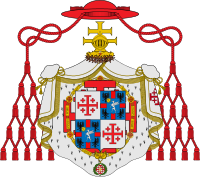 |
Nicola Canali |
| 1960-1972 |  |
Eugène Tisserant |
| 1972-1988 |  |
Maximilien de Furstenberg |
| 1988-1995 | 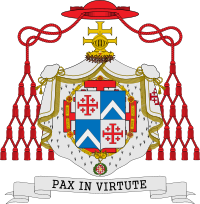 |
Giuseppe Caprio |
| 1995-2007 | 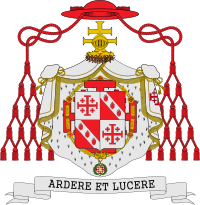 |
Carlo Furno |
| 2007-2011 |  |
John Patrick Foley |
| 2011- |  |
Edwin O'Brien |
Officers of the Grand Magisterium[16]
- Carlo Cardinal Furno, Grand Master Emeritus
- Fouad Twal, Grand Prior - the Latin Patriarch of Jerusalem
- Antonio Franco, Assessor
- Giuseppe Dalla Torre del Tempio di Sanguinetto, Lieutenant General
- Agostino Borromeo, Governor General
- Patrick D. Powers, Vice-Governor General
- Giorgio Moroni Stampa, Vice-Governor General
- Ivan Rebernik, Chancellor
Officials in the USA
- Raymond Teatum, Lieutenant USA Eastern
- Timothy Michael Cardinal Dolan, Grand Prior USA Eastern
- John J. Monahan, Lieutenant USA Northeastern
- Sean Cardinal O'Malley OFM Cap, Grand Prior USA Northeastern
- Max Douglas Brown, Lieutenant USA Northcentral
- Blaise Cupich, Grand Prior USA Northcentral
- Raymond Garrity, Lieutenant USA Southeastern[17]
- Archbishop Gregory Aymond, Grand Prior USA Southeastern
- Dennis M. Malloy, Lieutenant USA Southwestern
- Daniel Cardinal DiNardo, Grand Prior USA Southwestern
- Michael J. Ruck, Sr., Lieutenant USA Middle Atlantic
- Archbishop William E. Lori, Grand Prior USA Middle Atlantic
- Michael Scott Feeley, Lieutenant USA Western
- Roger Cardinal Mahony, Grand Prior USA Western
- P. Thomas Pogge, Lieutenant USA Northern
- Archbishop Joseph Fred Naumann, Grand Prior USA Northern
- Mary Currivan O'Brien, Lieutenant USA Northwestern
- Archbishop George Hugh Niederauer, Grand Prior USA Northwestern
Ranks
There are several grades of knighthood. Except for the highest grade, these are open to both men and women. The titles of the ranks, in English, are:
- Knight of the Collar
- Knight / Dame Grand Cross (GCHS)
- Knight / Dame Commander with Star (KC*HS / DC*HS), or Grand Officer
- Knight / Dame Commander (KCHS / DCHS)
- Knight / Dame (KHS / DHS)
In some jurisdictions the term "Lady" is used rather than "Dame," but this is a misnomer since the honorific term of Lady (Donna) refers to the wife of a Knight (Cavaliere). However, a woman upon whom the Order has been conferred is properly termed a "Dame" (Dama).
This Order is the highest distinction given to both laity and clergy. While laity can receive or be promoted to any rank, clergy's ranks are restricted thusly: Cardinals automatically are Knights Grand Cross; Bishops are automatically Commanders with Star; and priests start with the rank of Knight but may be promoted to Commander.
The Order of the Holy Sepulchre is State Honour bestowed nowadays by the Holy See on reigning Catholic monarchs or members of their royal families. Kings, Queens, Princes and Princesses are either given the rank of Collar or Grand Cross. Monarchs, Crown Princes and their consorts from Spain, Monaco, Belgium and Liechtenstein currently are, or previously have been, members of this Order.
Since the Order has its roots in the Canons of the Holy Sepulchre, priests of the Order are afforded the honorary rank of "Canons of the Holy Sepulchre," and they are entitled to the insignia of a Canon (i.e. mozetta for choir dress). Some of the priests of the Order prefer the honorary term of Canon to the title of Knight, which carries a connotation that may be considered improper for a priest. All priests who have been conferred knighthood in the Order may use the term "Canon," which is different from the title that is conferred by the Latin Patriarch of Jerusalem. However, the late Grand Master, John Cardinal Foley, said that this would be better applied to those priests who have the rank of Commander.
Members of the Order may receive awards of Special Distinction, and those Knights and Dames making a pilgrimage to the Holy Land receive the Pilgrim's Shell. These are generally awarded by the Grand Prior of the Order, the Latin Patriarch of Jerusalem.
There are also Decorations of Merit, which may be conferred on those who are meritorious but who cannot be members of the Order (for example, non-Catholics).
The honor of knighthood, and any subsequent promotions, are conferred by the Holy See through its Secretariat of State, which approves each in the name of and by the authority of the Pope. Each diploma of appointment once approved is sealed and signed in Rome by an official of the Secretariat of State (The Assessor for General Affairs) and the Cardinal Grand Master of the Order. The candidate is subsequently knighted or promoted in an elaborate ceremony with a cardinal or major prelate presiding.
Members of the Order are precluded from joining any other a Order that is Masonic or not recognized by a sovereign state, and must renounce any membership in such organisations before being appointed a Knight of the Holy Sepulchre. Members may be expelled from the Order in circumstances where they breach its rules of conduct.
 | ||||
| Ribbons | ||||
|---|---|---|---|---|
with Star |
||||
| Awards of Special Distinction | ||||
(of bronze) |
(of silver) |
(of gold) |
||
| Decorations of Merit | ||||
with Silver Star |
with Gold Star | |||
Heraldry [18]
Armorial Bearings of the Order


By ancient tradition, the Order uses the Arms attributed to the Kingdom of Jerusalem - which is a gold Jerusalem Cross on a silver/white background - but enamelled with red, the colour of blood, to signify the five wounds of Christ. The Jerusalem (or quintuple) Cross, or Cross of Godfrey of Bouillon, is a Cross Potent (each cross-piece having at the extremity a 'crutch-like' cross-bar) with four small crosses in the four angles. This prior use of this symbol was clearly documented in the 1573 Constitution of the Order.
Above the shield of the Armorial Bearings is a sovereign's gold helmet upon which are a crown of thorns and a terrestrial globe surmounted by a cross, flanked by two white standards bearing a red Jerusalem Cross. The supporters are two angels wearing dalmatic tunics of red, the one on the dexter bearing a Crusader flag, and the one on the sinister bearing a pilgrim's staff and shell. The motto is "Deus lo Vult" (God Wishes It).
The Seal of the Order is in the shape of an almond and portrays, within a frame of a crown of thorns, a representation of Christ Rising from the Sepulchre.
Heraldic Privileges of members
The Order of the Holy Sepulchre is one of only two Orders whose insignia may be displayed in a clerical coat of arms (the other being the Order of Malta).
Laypersons have no such restriction.
| Arms | Office | Description |
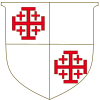
|
Clerics | Clerics quarter their Arms with those of the Order. |
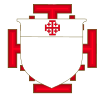
|
Patriarch Grand Prior and Assessor | The Arms of the Order are borne in Chief. |
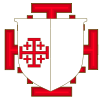
|
Knights of the Collar, Lieutenants, members of the Grand Magisteruim, and Grand Priors | The Arms are impaled with the Arms of the Order to the dexter. |

|
Other armigerous Lay Members | The Arms of lay members are placed on the Cross of the Order, a privilege which is not transmissable. |
| Hierarchy of the Order | ||
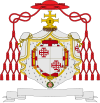
|
Cardinal Grand Master | The Cardinal Grand Master's Arms are quartered with those of the Order. The Galero and cross of a Cardinal are used, with the Mantle of the Order surmounted with the helm and crest of the Order, and with the relevant external ornaments. |
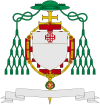
|
Patriarch Grand Prior and the Assessor | The Patriarch Grand Prior and the Assessor bear the Arms of the Order in the chief of his Arms, with the relevant external ornaments. |
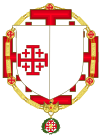
|
Knights of the Collar, Lieutenants, members of the Grand Magisterium, and Grand Priors | The Arms are impaled with the Arms of the Order to the dexter. Knights of the Collar surround the Arms with the Collar of the Order. |

|
Knights/Dames Grand Cross | The Arms are surrounded with a black ribbon from which is suspended a trophy and the Cross of the Order. |

|
Knight/Dame Commanders with Star / Grand Officers | The Cross of the Order is suspended from a trophy on a black ribbon coming from the sides of the shield. |
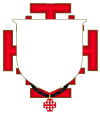
|
Knight/Dame Commanders | The Cross of the Order is suspended from a black ribbon limited to the base of the shield. |
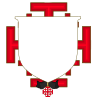
|
Knights and Dames | The Cross of the Order is suspended from the shield with a simple black knot. |
See also
References
- ^ Papal Orders of Knighthood
- ^ "Equestrian Order of the Holy Sepulchre of Jerusalem - Index, History". Retrieved 2009-01-04.
- ^ a b Official website page 1
- ^ History of the order form the Western Australia Lieutenancy website
- ^ Vatican history of the order
- ^ website of the English Lieutenancy
- ^ Catholic Encyclopedia
- ^ a b [Peter Bander van Duren, Orders of Knighthood and Merit]
- ^ Janus Møller Jensen. Denmark and the Crusades. 2007 p.41
- ^ Official website of the Order
- ^ [1]
- ^ Almanach de la Cour
- ^ Canon 1898, Ordo S. Sepulchre, Romae,1894.
- ^ http://en.lpj.org/2012/09/13/new-honorary-canon-of-the-holy-sepulchre-in-brescia/
- ^ http://www.barbiconi.it/schedabis.asp?idProdotto=260
- ^ [2]
- ^ http://www.sleohs.com/ Southeastern Lieutenancy of the United States of America
- ^ Most material from Appendix II of the Constitution of the Order
Sources
- Blasco, Alfred J. (1998). The Modern Crusaders. PenRose. ISBN 0-9632687-7-5.
- Noonan, Jr., James Charles (1996). The Church Visible: The Ceremonial Life and Protocol of the Roman Catholic Church. Viking. p. 196. ISBN 0-670-86745-4.
- Noonan, Jr., James-Charles (2012). The Church Visible: The Ceremonial Life and Protocol of the Roman Catholic Church Revised Edition. Sterling-Ethos. p. 139. ISBN 978-1-4027-8730-0.
- Bander van Duren, Peter Orders of Knighthood and of Merit
- Sainty, Guy Stair. Order of the Holy Sepulchre [3]
- Sainty, G. 2006. Order of the Holy Sepulchre. World Orders of Knighthood & Merit. Guy Stair Sainty (editor) and Rafal Heydel-Mankoo (deputy editor). United Kingdom: Burke's Peerage & Gentry. 2 Vol. (2100 pp).
External links
- Equestrian Order of the Holy Sepulchre of Jerusalem - website by the Order
- Equestrian Order of the Holy Sepulchre of Jerusalem - the Vatican website of the Order













